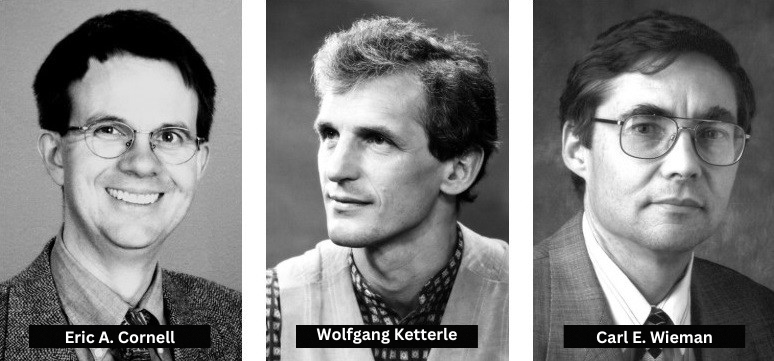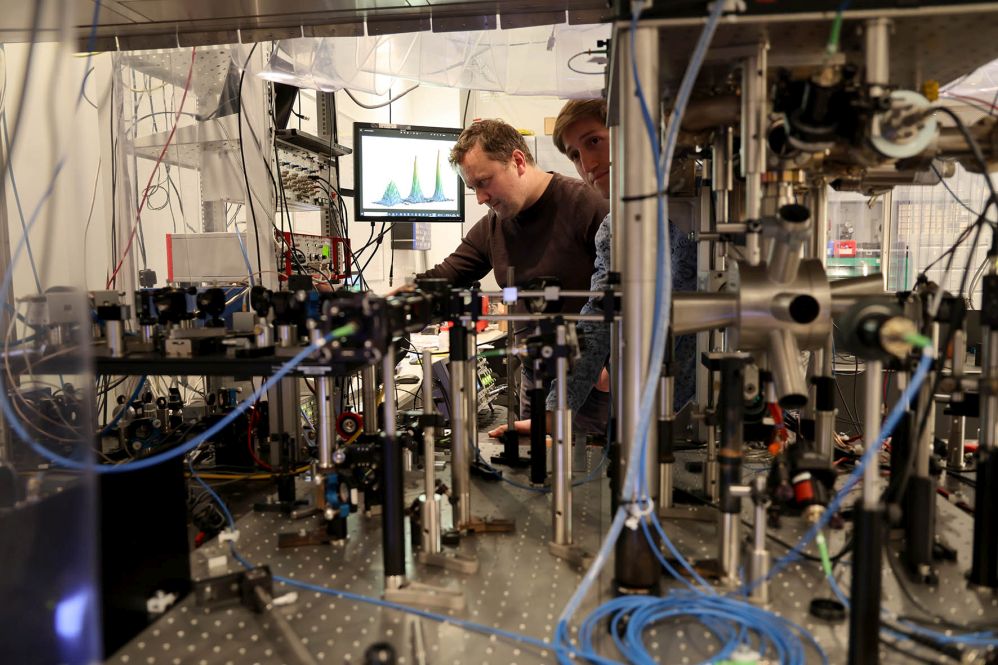

Cosmox Blogs
Bose Einstein Condensate: The Quantum State of Matter
In the field of quantum physics, there is a fascinating state of matter called the Bose-Einstein condensate (BEC). Predicted by Albert Einstein and Satyendra Nath Bose in the early 20th century, BEC was first observed in 1995, marking a breakthrough in quantum mechanics. In this state, particles, usually atoms, come together and behave as a single quantum entity, showing unusual properties that challenge classical physics.

What is Bose-Einstein Condensate?
A Bose-Einstein condensate is a state of matter that happens at extremely low temperatures, close to absolute zero (-273.15°C or 0 Kelvin). At this temperature, atoms lose their individual characteristics and merge into a single quantum state, acting more like waves than separate particles. This happens due to a quantum effect called Bose-Einstein statistics, which describes the behavior of indistinguishable particles, like certain types of atoms, at very low temperatures.
How was Bose-Einstein Condensate discovered?
The discovery of Bose-Einstein condensate in 1995 was a remarkable achievement in experimental physics. The key experiment was carried out by a team led by Eric Cornell and Carl Wieman at the Joint Institute for Laboratory Astrophysics (JILA) in Boulder, Colorado, and by Wolfgang Ketterle at the Massachusetts Institute of Technology (MIT). Building on previous work in laser cooling and atomic physics, the researchers used a combination of laser cooling and magnetic trapping to cool a gas of rubidium atoms to just a few billionths of a degree above absolute zero. By carefully controlling the experimental conditions and observing the behavior of the trapped atoms, they confirmed the existence of BEC through the unique signs of superfluidity and quantum coherence. This groundbreaking discovery not only confirmed the predictions of Einstein and Bose but also opened up new possibilities in the study of ultracold atomic physics.

How is it created?
Creating a Bose-Einstein condensate is a significant achievement in experimental physics. It involves cooling a thin gas of atoms, usually alkali metals like rubidium or sodium, to temperatures just above absolute zero using advanced techniques such as laser cooling and evaporative cooling. As the temperature drops, the atoms slow down and eventually reach a point where their wavefunctions overlap, leading to the formation of a single, unified quantum state.
Properties of Bose-Einstein Condensate
-> Superfluidity: One of the most interesting properties of BEC is its ability to flow without any resistance, a phenomenon known as superfluidity. This means that a BEC can move indefinitely without losing energy, showing frictionless motion.
-> Quantum Coherence: In a Bose-Einstein condensate, all the atoms are in the same quantum state, resulting in high coherence. This allows the BEC to act as a single, large quantum entity, with all its particles behaving in harmony.
-> Wave-like Behavior: Because of the wave nature of particles in a BEC, they show interference patterns similar to waves. This wave-like behavior leads to effects like diffraction and interference, much like what happens with light waves.
-> Extremely Low Temperatures: BECs are created at temperatures just a few billionths of a degree above absolute zero, making them some of the coldest substances in the universe. This ultra-low temperature is necessary to observe the quantum effects that define BEC.
Applications of Bose-Einstein Condensate
Initially studied for its fundamental importance in quantum physics, Bose-Einstein condensates have also found practical uses in various fields:
-> Precision Measurements: BECs are used in precise measurements of time, acceleration, and gravity. Their coherence allows for highly accurate interferometry, improving atomic clocks and inertial sensors.
-> Quantum Computing: BECs are promising candidates for quantum computing because of their ability to manipulate and control quantum states. Researchers are exploring how BECs can be used for quantum information processing and quantum simulation.
-> Atom Interferometry: BECs are used in atom interferometry experiments to study fundamental physics phenomena such as gravitational waves, dark matter, and the behavior of exotic particles.
-> Quantum Simulations: By controlling the interactions between atoms in a BEC, scientists can simulate complex quantum systems that are hard to study with classical computers. This capability opens up new ways to explore condensed matter physics, quantum magnetism, and other quantum phenomena.
Mathematical aspect of Bose-Einstein Condensate
To understand how a Bose-Einstein condensate forms, we need to look at the math behind it. The key idea is the Bose-Einstein distribution, which describes how indistinguishable bosons (a type of particle) occupy different quantum states at thermal equilibrium. This distribution comes from the principles of statistical mechanics and quantum mechanics.
The Bose-Einstein distribution function n(E) shows the average number of particles in a particular energy level E For a system of non-interacting bosons in a uniform potential, it is given by this formula:

At temperatures close to absolute zero, the exponential term in the denominator becomes very large, and n(E) increases significantly for the lowest energy states, leading to the accumulation of particles in the ground state. This is the main feature of Bose-Einstein condensation.
The critical temperature Tc at which BEC occurs can be determined by considering the system's density of states and the Bose-Einstein distribution. Below Tc, a large fraction of particles occupy the lowest energy state, signaling the start of BEC.
Experimental techniques for creating Bose-Einstein Condensates:
Creating a Bose-Einstein condensate in a lab requires precise control over temperature, pressure, and particle density. Several techniques have been developed to achieve these conditions, including:
-> Laser Cooling: Using laser light to cool atoms to ultra-low temperatures by taking advantage of the Doppler effect.
-> Magnetic Trapping: Using magnetic fields to trap and manipulate atoms, allowing the formation of dense clouds suitable for BEC.
-> Evaporative Cooling: Gradually removing the highest-energy atoms from a trapped gas, cooling it further and leading to the formation of BEC.
These techniques are essential for creating BEC in experiments and have made the study of this unique state of matter possible.
Emerging frontiers in Bose-Einstein Condensate research:
Recent advances in BEC research have opened up exciting new areas for exploration. Scientists are studying phenomena such as:
-> Spinor BECs: Expanding the study of BECs to include particles with internal properties, like spin, leading to complex behavior.
-> Dipolar BECs: Investigating the effects of long-range interactions in BECs composed of atoms with large magnetic or electric dipole moments.
-> Optical Lattices: Using standing waves of light to create periodic potentials for atoms, mimicking the behavior of electrons in crystals and enabling the study of quantum phase transitions and new quantum states.
These new research areas are expected to deepen our understanding of quantum systems and could lead to groundbreaking discoveries in condensed matter physics, quantum information science, and other fields.
Future prospects
As research into Bose-Einstein condensates continues, scientists are learning more about quantum systems and expanding our understanding of fundamental physics. With ongoing technological advancements and collaborations across disciplines, the study of BECs holds great potential for revolutionizing fields such as quantum computing, precision measurement, and quantum simulations.

Conclusion
In the world of quantum physics, the Bose-Einstein condensate is a remarkable example of quantum phenomena. Its transition from theoretical prediction to experimental reality has opened new doors in our exploration of the quantum realm. As scientists continue to study the properties and applications of BECs, they are uncovering more about the mysteries of quantum mechanics and paving the way for groundbreaking discoveries with far-reaching impacts.

Cosmox Blogs
A non profit organization that works on writing and delivering blogs on cosmology, natural sciences & environment, so that people can learn more about it. We even run a forums page, where our users interacts with each other and discuss about Cosmology, Natural Sciences & Astronomy. We even run an instagram and a youtube channel with podcasts.